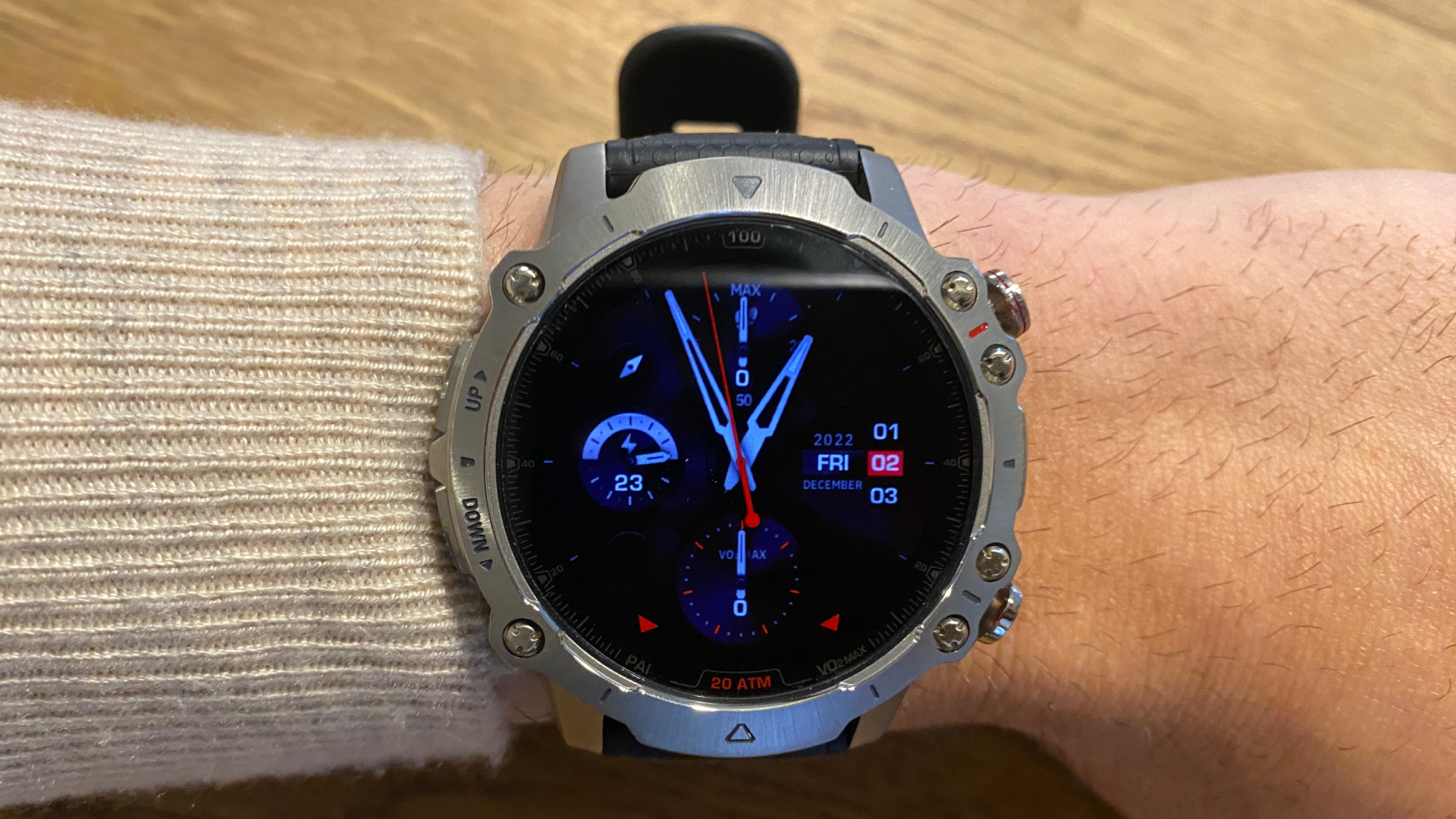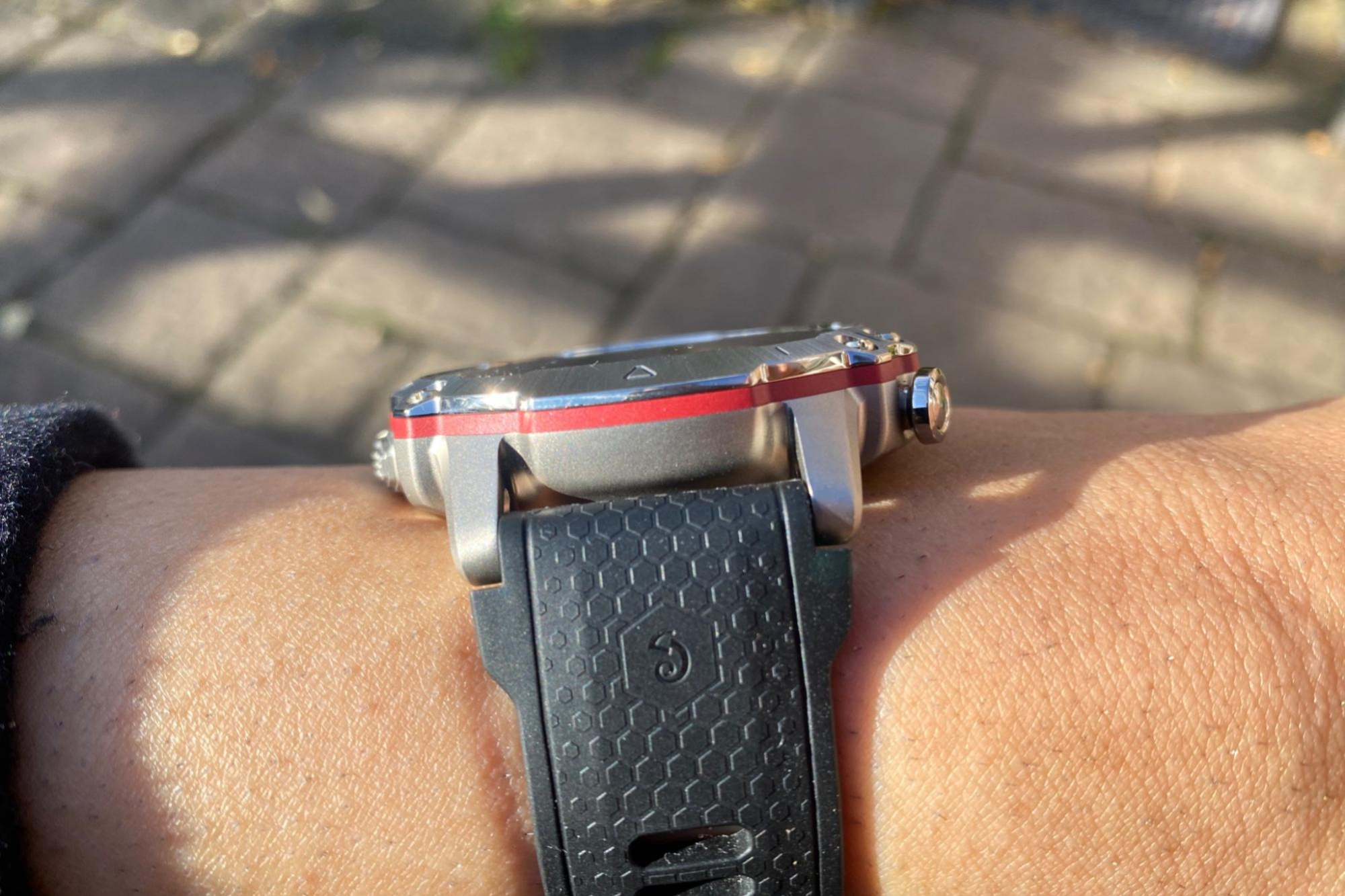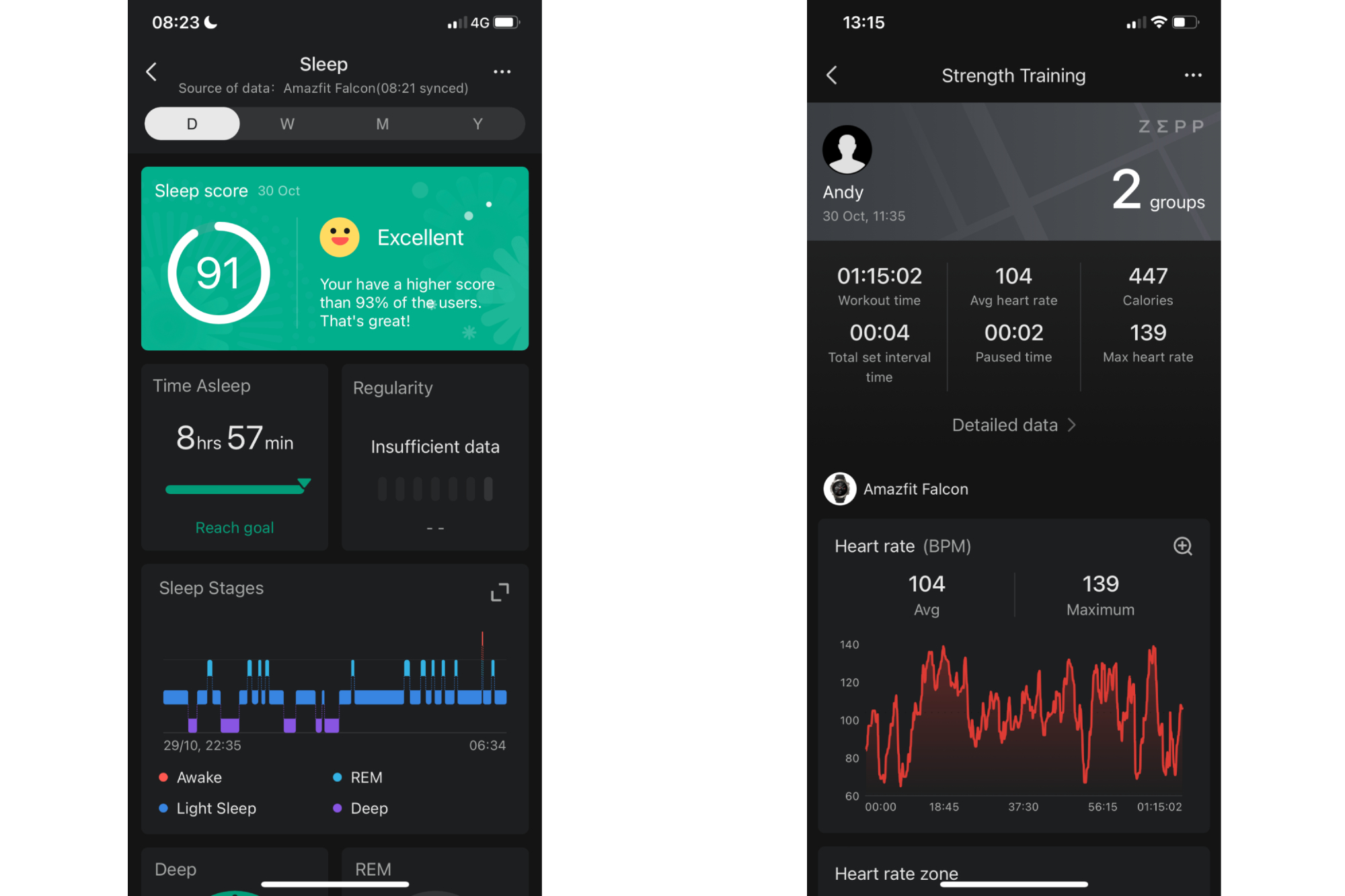Amazfit Falcon smartwatch review – exceptional battery life and a mid market price but don’t rely on the HR data
Boasting better battery life than even Garmin’s Fenix 7S solar model and (seemingly) accurate sleep tracking, it’s a shame the heart rate data isn’t accurate enough to rely on

The Amazfit Falcon can do what many smartwatches do, but at a bit of a cheaper price, whilst still using some of the higher-end materials usually exclusively found on flagship products. The execution of some aspects could be improved; the app isn’t quite as easy to use as some competitors and heart rate tracking accuracy is variable. However, the battery life is exceptional, it looks great and it will do more than enough to be a useful addition for those focusing on health and fitness rather than performance sport.
-
+
Incredible battery life
-
+
GPS tracks accurately
-
+
Buttons mean the watch can be used without touchscreen
-
+
Screen locks during activity and easily unlocked
-
+
Good value against competitors
-
+
Third part app compatibility
-
-
Heart rate tracking is hit and miss
-
-
Zepp coach needs improving for more than just health focus
You can trust Cycling Weekly.

Amazfit is a smartwatch company based in Hong Kong which specialises in fitness wearables. Alongside various smartwatch models, Amazfit also produces bluetooth headphones and other fitness gear.
Its goal is to bring smart wearables to the masses to help promote active and healthy lifestyles – which is one of the key benefits shared by the very best smartwatches for cycling. On the whole, I would say that the Amazfit Falcon does achieve this aim – albeit with a couple of caveats.
Amazfit Falcon: construction

The Falcon is made of premium materials, with a titanium body, sapphire crystal touchscreen and liquid silicone strap. This results in a watch that is lightweight, sweat resistant, and very strong. The sapphire crystal screen has a Mohs hardness rating of 9/10 (a diamond is 10/10, for reference).
Add to that it has been tested to withstand temperatures ranging between -40°C / -40°F and 70°C / 158°F and up to 200m of water pressure. There are also many different faces you can use on your watch to match your style and what metrics you want to see. There are four buttons, two action buttons on the right, and two up and down buttons on the left.
The 42mm screen itself uses HD AMOLED with a maximum brightness of 1000 nits. The battery has a 500 mAh rating giving it a claimed 14 day battery life, however throughout testing I found that 20 days was manageable when not used for tracking sports every single day. However, with ‘accuracy GPS’ enabled, that battery life drops down to a claimed 21 hours. Satellite tracking is done via Dual-band GPS and six satellite positioning systems to ensure maximum accuracy.
Health metrics that can be measured include heart rate, blood oxygen, stress levels, breathing rate, sleep quality, and sleep breathing. For those who like to be competitive with their health and fitness, the Falcon has a ‘Personal Activity Intelligence’ system. Hitting a score of 100 has been shown to lower the risk of hypertension and heart disease. Similar to Apple’s rings as a means of pushing you to be active and healthy. Heart rate is measured via the watch itself and you can connect a chest strap using BLE 5.0, should you wish.
The app behind the Falcon is the Zepp OS, which has access to multiple third party applications as well as the Zepp Coach. The Coach uses AI to plan your training and rest days based on the stress you incur during previous days. It can also plan your training and heart rate zones based on previous performance during training. In addition to that, you can also use the Zepp app to plan and structure your workouts and conduct more in-depth analyses.
Amazfit Falcon: the ride
Charging and getting the screen set up was very easy. All that was needed to finish off was downloading the Zepp app and registering to that. The first test was seeing how the heart rate tracked compared to a chest strap – a Wahoo Tickr, in this case. To this end, I entered into a Zwift race, a sure-fire way of getting your heart rate up to more maximal levels.
At the higher intensities, the Falcon tracked well and read within 1-2 BPM of the TICKR for the most part. However, further testing in sessions that caused a greater variation in heart rate did highlight that the Falcon’s HR tracking does have some delays.
When going from 120 BPM on the flats to 160 on a climb, the Falcon took a while to respond and then did not dip down again until a fair while after my actual HR had already dropped. You can of course link the Tickr to the Falcon, but it would be better if the inbuilt HRM was a bit more accurate. Still, for those doing multi-sports such as triathlon, the ability to link a chest strap will still provide you with the data you need.
Testing the GPS involved riding a twisty loop local to me, which combines some forested areas where I know signal is a little hit and miss, as well as going through some narrow town roads. For reference I was using a Wahoo Elemnt Bolt V2 to track GPS and the Falcon matched it perfectly. The Falcon and Zepp app also integrated seamlessly with Strava to upload workouts and data. You just need to open the Zepp app and sync it with the Falcon to upload all new workouts.
The automatic screen locking feature was very helpful in mitigating accidental touches of the screen or bringing up the wrong action. Equally, unlocking was easy using either of the left hand up or down buttons. One issue during gym sessions, though, was that I accidentally would press the lap button on the right of the device when my wrist was extended. I also found that the movement tracker and exercise monitor during gym workouts not to be particularly accurate, most exercises weren’t picked up on and the sets/reps counts were well off the actual number.

The screen itself works well and is certainly bright enough during most exercise conditions. A nice feature during exercises such as cycling through the winter, when I’m invariably wearing gloves, is that the Falcon can be used without actually using the touchscreen just by using the four buttons. I’ve had issues trying to use other smartwatches when I’ve had gloves on, so this is a very useful feature. The strap is also both secure and offers enough give that it doesn’t become uncomfortable. It also does not cause any irritation even when sweat levels are high.
Other health tracking metrics were interesting to use. The sleep tracking appeared to track well with when I actually fell asleep – as opposed to simply when I went to bed – and the wake time has been accurate as well. Restless nights also matched with when the Falcon said I was awake or not in deep sleep. As for the breathing rate, I can’t really comment on that, and the stress measurement did not seem to track with how I felt in myself. There were certainly stressful days where it didn’t think I was stressed, and relaxed ones where it said I was stressed.
The Zepp coach was an interesting addition, but I felt it almost erred on the side of caution with setting training. I also wonder if the stress readings not matching how I felt in myself influenced the way the app planned training. After days where it had measured higher stress, it wanted me to rest. Even though I know on those days I felt more than good enough to train and also that based on my schedule I wouldn’t be able to train the next day.
The biggest area that the Falcon impressed me in was the battery life. After a week of using the device for gym sessions or indoor rides without GPS, the battery was at 54%, well within the 14 day lifespan they say the Falcon has. However, even when using the Falcon for several hours of high accuracy GPS riding outdoors, the battery life was still only down to 20% after 14 days! After 20 days and the battery at 9% I decided to charge it. 2 hours later and it was back at 100%. This is a welcome change with a smartwatch as battery life on touchscreens like these has traditionally been significantly lower.
Amazfit Falcon: value and conclusion
Value-wise, the Falcon comes in very favourably at $499 / £499. The Garmin Fenix 7S with sapphire crystal and titanium shell comes in at $799 / £779 – which does come with solar charging, but actually a lower overall battery life. There is also the Tissot T-Touch Connect which comes in at $1,050 / £1,025, although this is getting more into premium-brand smart watches. The Apple Watch Ultra also has similar specs, but double the brightness at 2000 nits, however it is $799 / £849.
The Amazfit Falcon is a great value for money smartwatch that comes with a lot of materials and features that are normally exclusively used by far more expensive competitors. Plus the battery life is notably good. The Zepp app which accompanies the watch is easy to use and third party compatibility with apps such as Strava is great.
Some of the functionality needs refinement to match the higher priced options that this is going against, and may not be quite accurate enough for those looking to perform at a higher level in sports. However, the Falcon offers great functionality for recreational athletes and those looking to get fitter and healthier.

Thank you for reading 20 articles this month* Join now for unlimited access
Enjoy your first month for just £1 / $1 / €1
*Read 5 free articles per month without a subscription

Join now for unlimited access
Try first month for just £1 / $1 / €1
Get The Leadout Newsletter
The latest race content, interviews, features, reviews and expert buying guides, direct to your inbox!
Andy is a Sport & Exercise Scientist, fully qualified and experienced Cycling Coach, Sports Director, Freelance Writer, and Performance Consultant. He spent 3 years riding for a UCI cycling team and 7 years as a BC Elite rider, competing in prestigious events such as the Tour of Britain and the Volta a Portugal.
Graduating with a first-class honours degree in Sport & Exercise Sciences, he continues to pursue his interest in research in the field of Sport Science alongside managing his coaching business, ATP Performance. He also works as a Wind Tunnel operator and Performance Consultant at the Silverstone Sports Engineering Hub, working with individuals, teams, and businesses to optimise performance and develop products.
-
 Cycling's riders need more protection from mindless 'fans' at races to avoid another Mathieu van der Poel Paris-Roubaix bottle incident
Cycling's riders need more protection from mindless 'fans' at races to avoid another Mathieu van der Poel Paris-Roubaix bottle incidentCycling's authorities must do everything within their power to prevent spectators from assaulting riders
By Tom Thewlis Published
-
 Man hands himself in to Belgian police after throwing full water bottle at Mathieu van der Poel during Paris-Roubaix
Man hands himself in to Belgian police after throwing full water bottle at Mathieu van der Poel during Paris-Roubaix30-year-old was on Templeuve-en-Pévèle cobbled sector when television pictures showed the bottle hitting him in the face
By Tom Thewlis Published
-
 'I'll take a top 10, that's alright in the end' - Fred Wright finishes best of British at Paris-Roubaix
'I'll take a top 10, that's alright in the end' - Fred Wright finishes best of British at Paris-RoubaixBahrain-Victorious rider came back from a mechanical on the Arenberg to place ninth
By Adam Becket Published